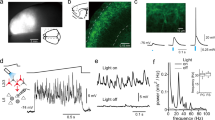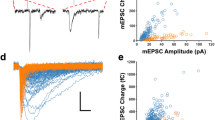Abstract
arising from B. V. Atallah, W. Bruns, M. Carandini & M. Scanziani Neuron 73, 159–170 (2012)10.1016/j.neuron.2011.12.013; N. R. Wilson, C. A. Runyan, F. L. Wang & M. Sur Nature 488, 343–348 (2012); S.-H. Lee et al. Nature 488, 379–383 (2012)
Parvalbumin-positive (PV+) and somatostatin-positive (SST+) interneurons are two principal subtypes of cortical GABAergic neurons that differ in morphology, physiological properties and postsynaptic targeting1,2,3,4. Although GABAergic inhibition is known to be crucial for shaping orientation tuning in the visual cortex5,6,7, it is unclear whether PV+ and SST+ interneurons have different roles. Recently, Atallah et al.8, Wilson et al.9 and Lee et al.10 addressed this issue by optogenetically manipulating each interneuron subtype, reaching different conclusions: some investigators found that SST+ neuron activation sharpens orientation tuning9, whereas PV+ neuron activation has little effect8,9, but others found that activation of PV+ but not SST+ interneurons sharpens orientation tuning10. To understand the cause for the discrepancy we examined the impact of several experimental differences among the studies—anaesthesia and the level and duration of optogenetic stimulation—and found that the discrepancies can be largely explained by differences in the level and duration of interneuron activation. There are replies to this Brief Communication Arising by Atallah, B. V., Scanziani, M. & Carandini, M. Nature 508, http://dx.doi.org/10.1038/nature13129 (2014) and El-Boustani, S., Wilson, N. R., Runyan, C. A. & Sur, M. Nature 508, http://dx.doi.org/10.1038/nature13130 (2014).
This is a preview of subscription content, access via your institution
Access options
Subscribe to this journal
Receive 51 print issues and online access
$199.00 per year
only $3.90 per issue
Buy this article
- Purchase on Springer Link
- Instant access to full article PDF
Prices may be subject to local taxes which are calculated during checkout


Similar content being viewed by others
References
Markram, H. et al. Interneurons of the neocortical inhibitory system. Nature Rev. Neurosci. 5, 793–807 (2004)
Ascoli, G. A. et al. Petilla terminology: nomenclature of features of GABAergic interneurons of the cerebral cortex. Nature Rev. Neurosci. 9, 557–568 (2008)
Xu, X., Roby, K. D. & Callaway, E. M. Immunochemical characterization of inhibitory mouse cortical neurons: three chemically distinct classes of inhibitory cells. J. Comp. Neurol. 518, 389–404 (2010)
Fishell, G. & Rudy, B. Mechanisms of inhibition within the telencephalon: “where the Wild Things are”. Annu. Rev. Neurosci. 34, 535–567 (2011)
Sillito, A. M. Inhibitory mechanisms influencing complex cell orientation selectivity and their modification at high resting discharge levels. J. Physiol. (Lond.) 289, 33–53 (1979)
Nelson, S., Toth, L., Sheth, B. & Sur, M. Orientation selectivity of cortical neurons during intracellular blockade of inhibition. Science 265, 774–777 (1994)
Katzner, S., Busse, L. & Carandini, M. GABAA inhibition controls response gain in visual cortex. J. Neurosci. 31, 5931–5941 (2011)
Atallah, B. V., Bruns, W., Carandini, M. & Scanziani, M. Parvalbumin-expressing interneurons linearly transform cortical responses to visual stimuli. Neuron 73, 159–170 (2012)
Wilson, N. R., Runyan, C. A., Wang, F. L. & Sur, M. Division and subtraction by distinct cortical inhibitory networks in vivo. Nature 488, 343–348 (2012)
Lee, S.-H. et al. Activation of specific interneurons improves V1 feature selectivity and visual perception. Nature 488, 379–383 (2012)
Xu, H., Jeong, H.-Y., Tremblay, R. & Rudy, B. Neocortical somatostatin-expressing GABAergic interneurons disinhibit the thalamorecipient layer 4. Neuron 77, 155–167 (2013)
Pfeffer, C. K., Xue, M., He, M., Huang, Z. J. & Scanziani, M. Inhibition of inhibition in visual cortex: the logic of connections between molecularly distinct interneurons. Nature Neurosci. 16, 1068–1076 (2013)
Author information
Authors and Affiliations
Contributions
S.-H.L. and Y.D. conceived and designed the experiments. S.-H.L. and A.C.K. performed experiments. S.-H.L., A.C.K. and Y.D. analysed the data. S.-H.L. and Y.D. wrote the manuscript.
Corresponding author
Ethics declarations
Competing interests
Declared none.
PowerPoint slides
Rights and permissions
About this article
Cite this article
Lee, SH., Kwan, A. & Dan, Y. Interneuron subtypes and orientation tuning. Nature 508, E1–E2 (2014). https://doi.org/10.1038/nature13128
Received:
Accepted:
Published:
Issue Date:
DOI: https://doi.org/10.1038/nature13128
This article is cited by
-
An adaptive behavioral control motif mediated by cortical axo-axonic inhibition
Nature Neuroscience (2023)
-
WDR5-HOTTIP Histone Modifying Complex Regulates Neural Migration and Dendrite Polarity of Pyramidal Neurons via Reelin Signaling
Molecular Neurobiology (2022)
-
FXR1 regulation of parvalbumin interneurons in the prefrontal cortex is critical for schizophrenia-like behaviors
Molecular Psychiatry (2021)
-
Inhibitory stabilization and cortical computation
Nature Reviews Neuroscience (2021)
-
Comprehensive characterization of oscillatory signatures in a model circuit with PV- and SOM-expressing interneurons
Biological Cybernetics (2021)
Comments
By submitting a comment you agree to abide by our Terms and Community Guidelines. If you find something abusive or that does not comply with our terms or guidelines please flag it as inappropriate.



